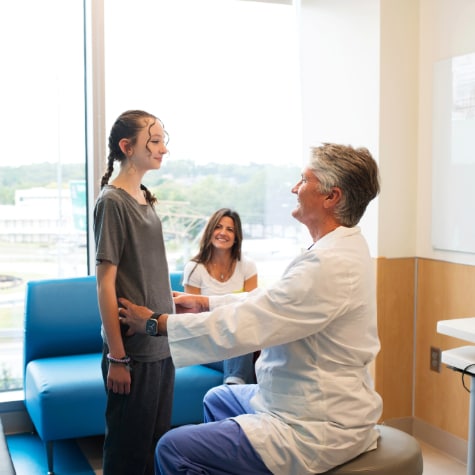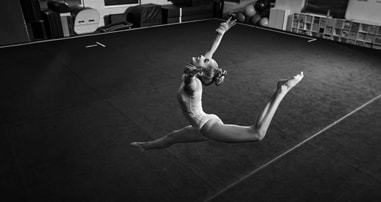Types of Spine Surgery for Growing Kids
Curves of the spine due to conditions like scoliosis, kyphosis, spondylolisthesis and some spinal injuries can sometimes be treated with bracing and physical therapy. While the orthotists and physical therapists at Children's Healthcare of Atlanta are specially trained to treat spine conditions without surgery, sometimes spinal surgery is necessary based on a child's age, spinal curve and anticipated remaining growth.
Spine surgery can help stabilize these curves, which prevents the curves from getting worse and can help improve spinal alignment. The type of spine surgery your child’s doctor may recommend can also depend on other factors like health history, previous treatments and age.
When a child is still growing, spine surgery can help to:
- Stop the curve’s progression, specifically in scoliosis and kyphosis patients.
- Balance the spine and pelvis region.
- Help your child sit and stand upright again and maintain healthy posture.
- Help improve lung function.
- Reduce pain caused by a spine condition or injury.
- Avoid complications and create a solution that keeps the spine's curve controlled throughout your child’s life.
While spinal fusion is the most common type of spine surgery to correct curves in the spine, it may not be the best option for kids or teens who are still growing.
In younger patients with a lot of growing to do, there are several types of spine surgeries that help prevent the spinal curve from worsening, while allowing the child to continue growing. This is commonly referred to as curve modulating.
Curve modulating (or adjusting) procedures combine a smaller number of fusions in the spine with special rods that can be extended. These devices function as an internal brace that allows continued spinal growth but limits the worsening of your child’s spinal curve.
Types of spine surgeries for growing children:
- Traditional growing rods
- Magnetic expansion control (MAGEC) rods
- Vertical expandable prosthetic titanium rib (VEPTR) device
- Shilla technique
- Vertebral body tethering
- Halo-gravity traction
Traditional growing rods
Traditional growing rods are placed along the spine and are surgically extended as a patient grows. They are used temporarily to help improve the spinal curve when a child still has a lot of growing to do.
The rods attach to the spine at the top and bottom of the curve with hooks or screws. The surgery is done through the back of the spine, under general anesthesia (while your child is fully asleep).
Traditional growing rods require a return trip to the operating room every six months for a mechanical lengthening. This keeps the spinal curve from getting worse while still allowing your child's spine to continue growing. Once your child is older and their spine has finished growing, the doctor will remove the traditional growing rods and perform a spinal fusion with metal rods that do not expand, in order to permanently keep the spine's curve from worsening.
MAGEC rods
MAGEC rods, or MAGnetic Expansion Control rods, are mechanical growing rods that help temporarily correct the spinal curve and control the curving of the spine in children who have quite a bit of growing left to do. MAGEC rods allow for continued, controlled growth of the spine.
What is MAGEC rod surgery?
Like traditional growing rods, the rods attach to the spine at the top and bottom of the curve with hooks or screws. The MAGEC rod surgery is done through the back of the spine, under general anesthesia (while your child is fully asleep).
How does a MAGEC rod work?
Unlike traditional growing rods, MAGEC growing rods can be lengthened in the clinic using a magnetic controller. The magnetic controller uses a magnetic force to painlessly lengthen the rods through the skin. Because the rods can be lengthened without surgery, it can be done more often to keep up with the growth of your child's spine.
Are MAGEC rods removed?
The doctor will remove the MAGEC rods and perform a spinal fusion once your child is older and their spine is finished growing.
VEPTR device
Vertical expandable prosthetic titanium rib, or VEPTR, surgery is performed on children with severe chest deformities and spinal curves and helps expand and support the chest wall so that a child can breathe. Children’s is one of only a few pediatric hospitals in the country that performs VEPTR procedures.
What is a VEPTR rod?
VEPTR stands for vertical expandable prosthetic titanium rib. The titanium rib is essentially a curved metal rod designed to help straighten a child’s spine and separate the ribs for lung growth and improved breathing. The rod is made of titanium, which is a strong metal that is also able to stay in a child’s body without rejection.
Is my child a good candidate for VEPTR surgery?
It is recommended for children between the ages of 18 months and 5 years—but other ages may benefit—and can help children who have scoliosis and other spine conditions, such as thoracic insufficiency syndrome.
What happens during the VEPTR surgery?
The VEPTR device works by attaching the rods vertically from rib to rib, or from rib to hip bone, which allows it to expand as a child grows. For a child with scoliosis, the ribs are separated during the first implant procedure. A VEPTR device will then be attached from the top of the rib cage to the bottom of the rib cage. Another device will be shaped to fit from the top of the rib cage to the lower spine. This way, the device controls the curvature of the spine through the ribs, which are attached to the spine.
As your child grows, the rod expands. Eventually, your child will need surgery to expand the rod farther and allow for more growth. When your child has finished growing, you and your child’s doctor will discuss whether the device is still needed.
After the initial surgery, the metal rod will need to be surgically expanded every four to six months until your child stops growing. Your child may also be fitted for a thoracolumbar sacral orthosis (TLSO) brace to wear after surgery.
Preparing for Spine Surgery
-
Growing Rod Surgery for Scoliosis
In younger patients who still have more growing to do but need a spine surgery to prevent their scoliosis from worsening, growing rod surgery is a growth-friendly option.
Vertebral body tethering (VBT)
While spinal curve-correcting surgeries can help treat patients who have quite a bit of growing left to do, there are other procedures that can help control the growth of the spine itself and correct spinal deformity, including vertebral body tethering (VBT).
VBT is an evolving technique that can help correct greater spine curves in patients who have a precise amount of growth remaining. Because this procedure relies on the child’s remaining growth to straighten the spine, it’s possible for the spinal curve to over- or under-correct, and it can be difficult for doctors to predict how much the spinal curve will be corrected until after the surgery. However, a limited or growth-friendly procedure like VBT may delay the need for a spinal fusion for some spine patients.
Shilla technique
Shilla technique is a special type of spinal fusion that allows continued, modulated growth of the spine. A short fusion is performed at the most curved portion of the spine, known as the apex. Then metallic anchors, or screws, are placed at the apex of the spine's curve, as well as the top and bottom of the curve. The rods and screws of the short spinal fusion at the apex of the curve are attached tightly to one another. Meanwhile, the screws at the top and bottom of the curve are attached less tightly to allow the rods to slide.
As the spine grows, these special sliding screws grow along the rod. The technique allows growth, but only along the rod, which keeps the spine's curve from worsening.
Halo-gravity traction, also known as halo traction, is a procedure that will sometimes be performed in advance of a child’s spine surgery. Halo traction uses a large metal halo ring and pulley system to gently stretch and straighten a curved spine prior to spine surgery. Not every child who needs spine surgery will require halo traction, but it can be an option even if your child is still growing.
Spine surgery is a big deal—especially when it’s your child. So you want them in the hands of an experienced pediatric spine surgeon. Here are some things to consider as you plan for your child's surgery.
Our team knows how to keep kids and teens safe during spine surgery.
Our No. 1 focus is patient safety and quality. Our spine surgeons are leaders in optimizing pediatric spinal fusion safety best practices across the country, as we perform more spine surgeries than any other pediatric hospital in the U.S.*
Our operating room team of surgeons, pediatric anesthesiologists and nurses follow special procedures that help keep patients safe, including:
- Special neuromonitoring to closely observe the spinal cord and help prevent neurological injuries.
- Medication and safety measures to minimize blood loss.
- Robust infection prevention program that helps us avoid surgical site infections.
We have also earned Level 1 status from the American College of Surgeons for Children’s Surgery Verification—its highest designation. No other hospitals in Georgia have achieved this level. So when your child needs surgery, you can take comfort in knowing that we meet the highest distinction.
We guarantee your child will have a pediatric anesthesiologist, specially trained to treat kids and teens.
A pediatric anesthesiologist will be with your child throughout their entire spine surgery to help monitor their condition while the surgeon works, and as they wake up and recover. Our anesthesiologists are specially trained to work with children and help provide a safe environment for kids, from infants with the most difficult issues to teens.
Safely caring for children is always our No. 1 concern.
Our team guides you step by step through the process. Before surgery, our team meets with spine patients and their families to talk through the surgery plan and concerns. The team will provide you with a spine surgery handbook and other resources to help prepare your family. Our dedicated spine liaison can help your family with any questions before, during and after care, and serve as a single point of contact for your child and their primary care provider. Our goal is to help reduce anxiety and make sure all questions are answered before your child’s surgery.
The spine liaison will help coordinate care by:
- Providing information about lodging and key contacts for those who live outside metro Atlanta.
- Arranging travel accommodations to Atlanta and transportation while in Atlanta.
- Helping families navigate our hospitals and escorting them as needed.
- Assisting with the hospital intake process and clinic visits.
- Writing treatment plans for your child’s referring provider.
- Assisting in arranging the use of durable medical equipment after your child is released from the hospital.
- Coordinating interpretation services.
- Coordinating financial planning with insurance companies.
- Following up with you after your child’s procedure or visit.
- Communicating with and coordinating requests for your child’s referring provider.
Contact concierge services at 404-255-1933.

Meet Our Orthopedic Spine Surgeons
Your child’s spine will be in expert hands with our pediatric-specialized spine surgeons. When you come to Children’s, you can rest assured that more parents trust us for their child’s spine surgery than any other children’s hospital in the country*.
find a specialist*Pediatric Health Information System (2024), as prepared by the Children’s Hospital Association. This report compares clinical data annually for more than 52 pediatric hospitals in the U.S.
Contact Us 404-255-1933



